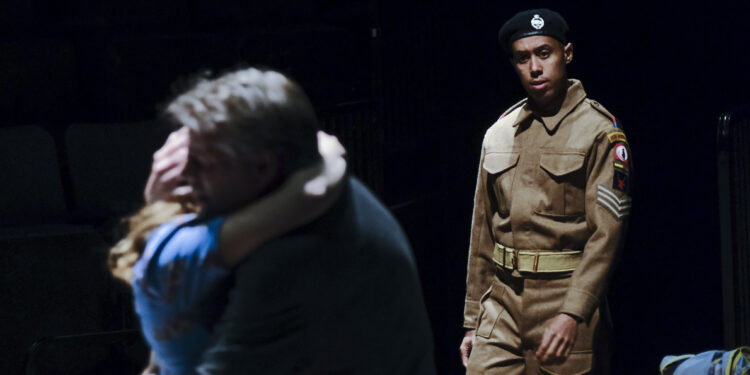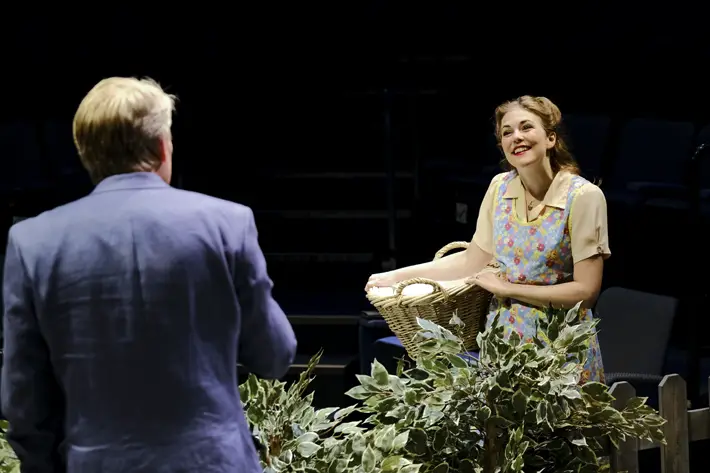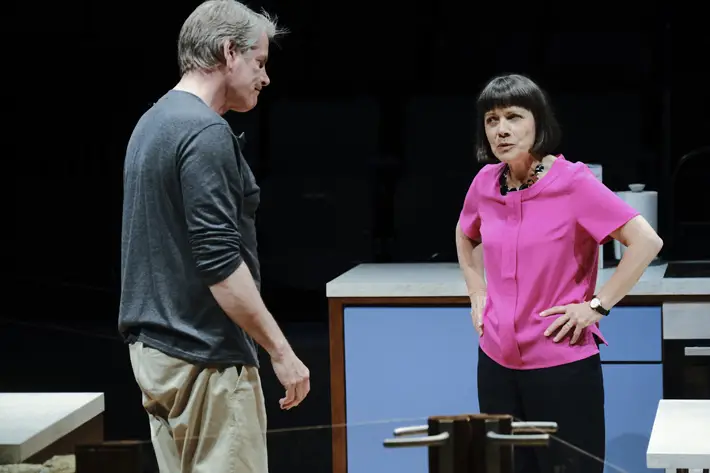The Girl Next Door – Review – Stephen Joseph Theatre

By Eve Luddington, June 2021
Thwarted, dammit! That’s what I thought when, two days before my first theatre trip in nearly 18 months, I was told to self-isolate. But it wasn’t so terrible after all: thanks to the resourcefulness of the Stephen Joseph Theatre team, I watched a live performance of a world premiere, written and directed by that master of theatre, Alan Ayckbourn. It was streamed to my laptop and, with the help of an HDMI lead, screened on my TV. The camera work was impeccable, taking the screen audience right into the action. If ingenuity, commitment and talent were all it took for theatre to survive this pandemic, we’d be laughing.
The Girl Next Door is Alan Ayckbourn’s 85th play yet it feels fresh and innovative. The basic idea is simple: take two neighbouring London households on one August day and introduce them to each another. Ayckbourn’s twist is to set one household in the pandemic of 2020 and the other in war-torn 1942 (when the playwright was three years old). On stage, the kitchen and garden of each house, separated by a hedge, are shown in contrasting detail.
“Final straw”
60 year-old Rob is in a mess. His dalliances with women destroyed his first marriage, his second wife has left him and his work as an actor has dried up. He can find nothing to do in semi-lockdown except irritate his sister, Alex, who’s moved in to support him while she Zoom-works for the government. Rob’s latest wheeze, to buy a blow-up doll for sexual relief, could be the final straw for Alex. So, instead of googling sex toys, he ogles a young woman he’s noticed next door, strolls into his garden and introduces himself over the hedge. He assumes the woman is looking after his neighbours’ house while they spend the pandemic in their second home. But no, Lily Tindall says she’s lived next-door for seven years. Rob’s lived in his house for 10. Naturally, both are perplexed.
Rob’s confusion turns to disbelief that Lily doesn’t recognise him as the firefighting hero from the popular TV soap he once starred in. Despite his bruised ego, he’s keen to know an attractive young woman and offers to mend the faulty kitchen tap she mentions. When he enters her garden, he doesn’t notice at first the neat vegetable plot that has replaced his neighbours’ lawn. In her kitchen, he thinks the 1940s décor is a TV set: this man is seriously obsessed with himself and his immediate world. But when Lily walks out of the room and disappears through an invisible wall, Rob is jolted into realising something more impossible has happened than a global pandemic and his personal misfortune. He has walked into 1942, into a world at war.
“Lightness of touch”
It’s quite common for comparisons to be made between the Covid pandemic and world wars but Ayckbourn, through the magic of his dramatic imagination, draws us into Lily’s world; a world of evacuated children and of air-raids, and makes it live for us. Lily talks of sharing her rations with friends and family. She talks of missing her husband, Alf, who’s fighting in North Africa. And later, when Rob takes her into his kitchen and introduces her to the dishwasher, the fridge and freezer, she’s struck dumb. Eventually, she comes out with, “What do you find to do all day?” We, the audience know: Rob spends a lot of the day feeling sorry for himself.
The contrast between Lily’s and Rob’s approaches to straitened circumstances seems to be about more than character. As the play progresses, Ayckbourn compares more of the differing social norms and expectations of the two eras. When Alf unexpectedly arrives home on leave, he talks movingly about his fears but says: “What really matters is Lil. That she survives. The kids survive.” That’s what he’s fighting for. With a lightness of touch which nevertheless has impact, Ayckbourn suggests that people were more emotionally and socially reserved in the war years than today, and less selfish.
But, whatever their faults and foibles, the characters begin to care about each other, and we care about them too. Ayckbourn creates the plays’ emotional climaxes out of the characters’ concerns for one another – using the timeline as a technical tool to show the universality of human feeling and compassion. For example, Rob and Alex, armed with some internet research into events of the war, wonder if they can warn Lily and Alf of impending danger and so save them from tragedy.
“Totally engaging”
So the play deals with heavy matters but it does so with humour, tenderness and dramatic prowess which are fully and entertainingly exploited by Ayckbourn’s own direction.
Two casts of actors are used in the production so that if one ‘bubble’ has to isolate, the show will go on. I saw the Red Team. All four were entirely believable: they had rapport between themselves and built a strong relationship with the audience which came across even on the screen. Bill Champion as Rob captured the suave actor with a fragile ego beautifully. Alexandra Mathie portrayed the exasperated, unimaginative but caring Alex very effectively. As shrill Cockney Lily who manages good cheer in terribly difficult circumstances, Naomi Petersen felt like someone I know. And Linford Johnson’s Alfie, a cocky lad whose swagger dissolves as he talks about the war, made me want to hug him.
Kevin Jenkins, the designer; Jason Taylor, lighting designer, and Paul Stear, associate sound designer, bring more talent to this excellent production: it’s no mean feat to recreate two kitchens and gardens, different weather conditions and a bombing raid on one smallish, round stage.
The Girl Next Door has fewer laughs than many of Ayckbourn’s previous plays but it is totally engaging, heartwarming and touching. The final climax brought a lump to my throat as it showed the heart beneath the skin of human beings.
images: Tony Bartholomew












